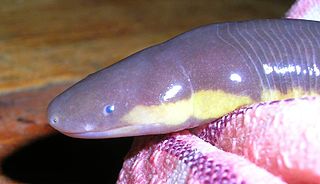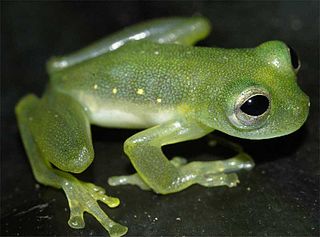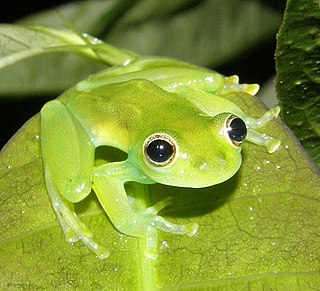
Ichthyophis is a genus of caecilians found in Southeast Asia, the southern Philippines, and the western Indo-Australian Archipelago.

The glass frogs belong to the amphibian family Centrolenidae, native to the Central American Rainforests. The general background coloration of most glass frogs is primarily lime green, the abdominal skin of some members of this family is transparent and translucent, giving the glass frog its common name. The internal viscera, including the heart, liver, and gastrointestinal tract, are visible through the skin. When active their blood makes them visible; when sleeping most of the blood is concealed in the liver, hiding them. Glass frogs are arboreal, living mainly in trees, feeding on small insects and only coming out for mating season. Their transparency conceals them very effectively when sleeping on a green leaf, as they habitually do. However, climate change and habitat fragmentation has been threatening the survival rates of the family.

Cochranella is a genus of glass frogs, family Centrolenidae. They are found in Central America from Honduras southward to the Amazonian and Andean cloud forests of Colombia, Ecuador, Peru, and Bolivia.

Hyalinobatrachium is a genus of glass frogs, family Centrolenidae. They are widely distributed in the Americas, from tropical Mexico to southeastern Brazil and Argentina.

Dendropsophus is a genus of frogs in the family Hylidae. They are distributed in Central and South America, from southern Mexico to northern Argentina and Uruguay. They are sometimes known under the common name Fitzinger neotropical treefrogs or yellow treefrogs
Cochranella litoralis is a species of frog in the family Centrolenidae. It is known from the Pacific lowlands of southwestern Colombia and northern Ecuador. The specific name litoralis refers to the proximity of the type locality to the sea.
Teratohyla adenocheira is a species of frogs in the family Centrolenidae. It is known from the Noel Kempff Mercado National Park, its type locality in eastern Bolivia, as well as more widely from Brazil, in the states of Mato Grosso, Pará, and Rondônia. The species' closest relative is T. Midas.
Nymphargus balionotus is a species of frog in the family Centrolenidae. It is found in the Andes of Colombia and Ecuador. Common names Mindo Cochran frog and mottled glassfrog has been coined for it.
"Cochranella" duidaeana, commonly known as the Duida Cochran frog, is a species of frog in the family Centrolenidae. It is endemic to Cerro Duida, Venezuela. The generic placement of this species within the subfamily Centroleninae is uncertain.

Teratohyla midas is a species of frog in the family Centrolenidae, which are also known as glass frogs. The species Teratohyla midas was first recorded in 1973 by Lynch, J. D., & Duellman, W. E. This Amazonian species appears to be semi-transparent with gold flecks on its back. Though many species of the glass frog, Centrolendidae, are similar in terms of diet and habitats, they vary greatly among limbs and other physiologies. Because of the similarities between T. midas and other glass frogs, Centrolendidae, researchers often group T. midas together with other species within the same family.

Cochranella nola is a species of frog in the family Centrolenidae, the glass frogs, so named because of the transparent skin on the underside of the abdomen through which the internal organs can be seen. This species is endemic to Bolivia where it is found in the Andean foothills in the Santa Cruz Department. Its natural habitats are subtropical or tropical moist montane forests and rivers. The scientific name nola is Latin for "small bell", and refers to the high-pitched, bell-like call of the male in the breeding season.
"Cochranella" riveroi is a species of frog in the family Centrolenidae. It is endemic to Cerro Aracamuni, Venezuela. The generic placement of this species within the subfamily Centroleninae is uncertain.

Teratohyla spinosa is a species of frog in the family Centrolenidae. It is found in the Pacific lowlands of northern and central Ecuador and western Colombia, northward on the Pacific slopes Panama and Costa Rica, as well as on the Caribbean slopes of Costa Rica, Nicaragua, and Honduras.
"Cochranella" xanthocheridia is a species of frog in the family Centrolenidae. It has an uncertain generic placement within subfamily Centroleninae; molecular data are not available and morphological and behavioural characters do not unambiguously place it in any specific genus.

The powdered glass frog or Chiriqui glass frog is a frog species in the glass frog family (Centrolenidae). The species is found from north-central Honduras south to northwestern Ecuador.

Incilius is a genus of toads in the true toad family, Bufonidae. They are sometimes known as the Central American toads or Middle American toads and are found in southern USA, Mexico, Central America, and northern Pacific South America. They are an ecologically and biogeographically diverse group of toads, including micro-endemic species such as Incilius spiculatus that are restricted to undisturbed cloud forests, and widespread lowland species such as Incilius valliceps that predominantly occur in disturbed habitats.

Centroleninae is one of two subfamilies of the family Centrolenidae. It has nine genera distributed in Central America from Honduras south and east to northern and central South America. As of mid 2015, it contains 117 species.











